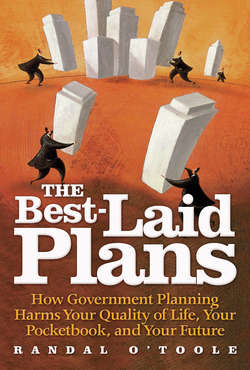Читать книгу The Best-Laid Plans - Randal O'Toole - Страница 30
На сайте Литреса книга снята с продажи.
The Decisionmaker Problem
ОглавлениеNo matter how smart the planners or how good their intentions, no plan will ever reduce every variable to a number that can be put into a computer program. Even things that can be quantified are not always comparable; for example, how should we rationally weigh the tradeoff between saving endangered species and saving jobs? Due to the subjective nature of planning, different people will interpret many elements of the plan differently. Into this pool of vagueness steps the decisionmaker—an elected official, legislative body, or director of a bureaucracy—who is conditioned by incentives to make a particular decision regardless of the plan.
The decisionmaker may be corrupt, motivated by under-the-table bribes, or promises of cushy jobs once retired from his or her current position. More likely, the decisionmaker has a set of goals that are heavily conditioned by the years spent climbing the bureaucratic or political ladder. Decisionmakers know that certain decisions will likely be rewarded by voters or the legislators who fund the agency, while others might be punished. No matter what the plan says, the decisionmaker will listen to those who cast their ballots or write the checks or face replacement with someone who will.
Elected officials’ incentives differ from agency officials’, but neither guarantee that the public interest is foremost in their minds. Government agencies are best thought of as ecosystems in which various ideas compete and evolve in response to outside forces— the most important of which is the agency’s budget. Most environmental and social problems have vague or uncertain causes, and there is often wide disagreement within agencies like the Forest Service, Environmental Protection Agency, and Department of Transportation about what the actual goals of the agencies should be and how they should achieve those goals. The ideas that win out are the ones that add the most to the agency’s budget.
For example, timber cutting was a dominant part of the Forest Service’s management of the national forests from about 1960 through 1990. When environmental challenges and internal dissension led to an 85 percent reduction of timber sales, something of a vacuum formed within the agency. If not growing and cutting trees, what should now be the primary mission of the Forest Service: Ecosystem management? Recreation? Watershed restoration? Advocates for each of these views competed for attention within the agency.
The answer came in 2000, when the Los Alamos fire burned several hundred homes and Congress responded by giving the Forest Service a 38 percent increase in its budget, nearly all for fire. Today, fire prevention and suppression dominate the Forest Service’s budget, staffing, and operations. No one in the agency deliberately said, “I am going to maximize the Forest Service budget by manufacturing a fire crisis.” But thanks to a fire crisis that some say is not real, the agency now enjoys the largest annual budgets in its history.28
If the goal of government agencies is to maximize their budgets, the goal of elected officials is to get reelected. While they might need to please voters, it is more important to please campaign contributors. One reason why rail transit has become so popular in U.S. cities is that its high cost to taxpayers translates to significant profits for engineering and design firms, construction companies, railcar manufacturers, and others in the rail industry—profits none of them would get if cities relied exclusively on buses. In 2000, Portland city commissioner Charles Hales encountered a strong challenge for his seat on the city council from someone who opposed rail transit. Hales easily raised nearly three times as much money as the challenger, much of it coming from firms that built either rail transit or subsidized real-estate developments near rail stations.29
Given the imperative to maximize budgets or get reelected, decisionmakers will not spend much time wading through planning data, forecasts, and models. Instead, they are likely to base their decisions on preconceived notions shaped by their budgetary and electoral experiences. The decisions they make, then, will be subjective and unscientific no matter what the quality of the actual planning process.
